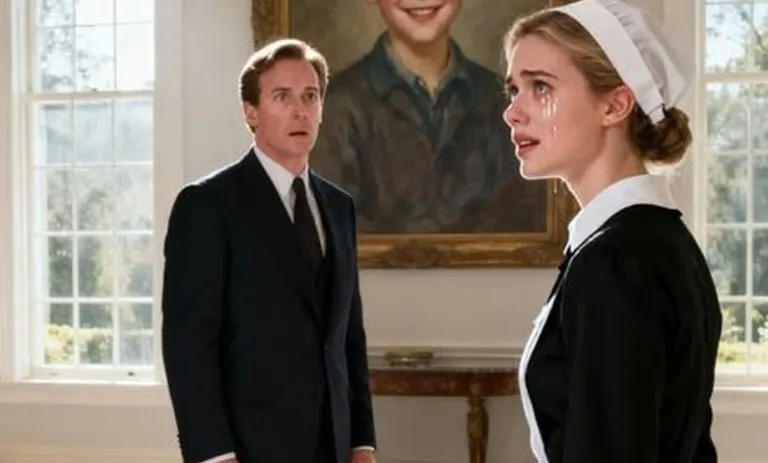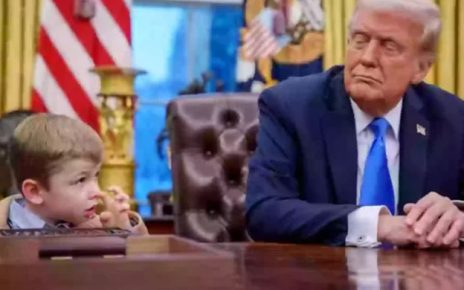The Portrait That Spoke
“Sir, this boy lived with me at the orphanage until he was fourteen,” said the cleaning lady, her voice trembling as it echoed through the silent hallway of the mansion. The sound shattered the calm luxury that filled the place.
Arthur Menezes froze before the old portrait hanging on the wall. It felt as if the floor beneath him had disappeared. The boy in the painting looked exactly like his younger brother—his brother who had vanished more than thirty years ago.
A lump formed in his throat. The same gaze. The same hair. The same pure expression he remembered from his childhood. The woman’s hands shook.
“I knew him as Daniel,” she whispered. “He never spoke of his family.”
Arthur’s breath caught. “You’re sure?”
“Yes, sir. I grew up with him. He protected me when no one else did.”
The Brother Who Never Came Home
Arthur Menezes had everything—wealth, prestige, the respect of an entire city. He lived among contracts, meetings, and elegant dinners, yet none of it could fill the emptiness inside him.
Because no amount of success could erase the wound left by the disappearance of his younger brother, Lucas, who had been taken when he was only four.
The case had shaken their whole family. Their father, a respected lawyer, and their mother, a gentle music teacher, had searched endlessly. Police helicopters, search dogs, news reports—nothing brought the boy home.
It happened one quiet Sunday morning at Central Park. The nanny looked away for just a moment, and Lucas vanished among the trees. Arthur, only eight at the time, promised himself that one day he would find his brother again.
Years passed. His mother’s health faded, and his father buried himself in work. The family’s piano, once filled with music, became silent. And the photo of little Lucas sat on top of it—yellowed with time.
The Woman with a Secret
Two weeks earlier, a new cleaning lady had arrived at the mansion. Her name was Clara—a quiet woman from the countryside, polite and soft-spoken, always carrying an air of mystery.
Arthur hardly noticed her until that afternoon when he found her standing frozen before the portrait.
“Has something happened?” he asked.
She turned, tears filling her eyes. “Sir, that boy lived with me at the orphanage until he was fourteen. We called him Daniel.”
Arthur stared at her. “What did you say?”
She nodded, gathering her courage. “He used to tell stories about a house with a piano, a garden, and an older brother who called him ‘my champion.’ No one believed him. But I did.”
Her words made Arthur’s heart pound. Could this be the truth he had been chasing for decades?
The Forgotten Child
Clara explained everything she remembered.
Daniel had been brought to the São Vicente orphanage at six years old by a woman who claimed to be a social worker. She said both his parents had passed away in an accident. He grew up there quiet but kind, with a gift for drawing.
When he saw reports about missing children, he would cry silently. And one day, after a fight at the orphanage, he ran away and was never seen again.
Arthur felt the years of silence close in on him. He decided to uncover the truth once and for all.
The Orphanage and the Drawing
The next morning, Arthur hired a private investigator and brought Clara with him to the old São Vicente orphanage. The building was falling apart, but an elderly nun, Sister Madalena, still lived there.
When she saw the portrait, her face turned pale. “My goodness… Daniel. I remember him. Such a gentle boy.”
Arthur compared the records and found something alarming—the day Daniel arrived at the orphanage was the same day the police ended the search for his missing brother.
“How did he end up here?” he asked.
The nun explained that a woman with false documents had brought the child, claiming he was an orphan. The papers had been accepted without question during a chaotic time in the country.
Arthur clenched his fists. Everything made sense now—the kidnapping, the false leads, the silence. His brother had been living just a few miles away all these years.
Then the nun mentioned something else. Before Daniel disappeared, he left behind a drawing.
It showed a big house, a piano, and two children holding hands. In one corner, in shaky handwriting, were the words: “I am Lucas Menezes. Someday my brother will find me.”
Arthur and Clara both wept. The truth was finally taking shape.
Searching for the Lost Years
Arthur returned home and placed the drawing beside the portrait. The resemblance was undeniable.
He began searching every record, every report, until a lead surfaced—someone named Daniel Lucas Menezes had been hospitalized years ago after an accident.
Arthur and Clara traveled immediately. A doctor at the old hospital remembered the young man.
“He had memory problems,” the doctor said softly. “Quiet boy, always drawing. He used to sketch children and pianos.”
From an old folder, the doctor pulled out another drawing. It was the same house, the same two children.
Before leaving the hospital, the man had left a note saying he was returning to the orphanage in São Vicente.
Arthur and Clara went there again. The building was abandoned, covered in ivy. Inside, on one cracked wall, they found new drawings—fresh, yet faded by time.
A house. A piano. And beneath it, the words: “I came back, but no one was waiting.”
Clara broke down. “He returned, Arthur. He came back.”
Arthur’s eyes filled with tears. His brother had tried to find home… and been forgotten again.
The Reunion
Weeks later, one of the investigators brought new information. In a small mountain town, a street artist had been signing his work as Lucas Menezes.
Arthur and Clara drove there at once. The town square was full of light, laughter, and small market stalls. And then Clara saw him.
A man with a short beard sat painting a portrait of a child, his eyes calm and focused. Something about him felt painfully familiar.
She approached slowly. The man looked up. “I know you,” he murmured. “From the orphanage… Clara.”
Her tears fell instantly. “Yes, it’s me.”
Arthur stepped forward, voice trembling. “Lucas.”
The man froze, confused.
Arthur pulled the old drawing from his coat. “Do you remember this?”
Lucas took the paper with shaking hands. The moment he saw it, tears filled his eyes. “I dreamed of this house,” he whispered. “Of a piano… of a brother who promised to find me.”
Arthur embraced him tightly. “I never stopped searching.”
People around the fair watched in silence as two grown men clung to each other, their lost years dissolving in a flood of tears.
The Piano’s Song
Lucas moved into the mansion for recovery. Slowly, the memories returned—the scent of the garden, the sound of his mother’s piano, the laughter of his brother.
Clara stayed by their side, helping them rebuild what time had taken.
One afternoon, Arthur found an old letter their mother had written years ago:
“If fate ever brings Lucas back, tell him the piano is still waiting. Love never forgets.”
That night, Arthur sat at the piano, his fingers trembling as he played the first notes. Lucas joined him, following the melody by instinct.
For the first time in three decades, the house was filled with music again.
Clara stood by the doorway, smiling through her tears. The silence that had haunted the mansion was finally broken.
Turning Pain Into Hope
As they rebuilt their lives, one last secret came to light. The woman who had taken Lucas to the orphanage was identified—a nurse named Teresa Vilar. She had arranged illegal adoptions for wealthy families.
Arthur chose not to seek revenge. “The past has taken enough from us,” he said quietly.
Instead, he founded an organization in his mother’s name, dedicated to reuniting missing children with their families. Clara became its coordinator, and Lucas—now a painter—designed the foundation’s logo: two children holding hands before a piano.
During the opening ceremony, Arthur spoke to the crowd:
“This story began with a promise—a promise kept alive by love. The world may forget, but love never does.”
Lucas embraced him before everyone. “Love found us again, Arthur. Even after everything.”
Clara looked at the portrait hanging on the wall, the same one that had started it all. For the first time, it seemed to smile.
And in that mansion where sorrow once lived, hope was reborn. Because time can blur memories—but it can never erase the love that remembers.
Support our channel by liking this video. We’ll be back with another story. Take care.




